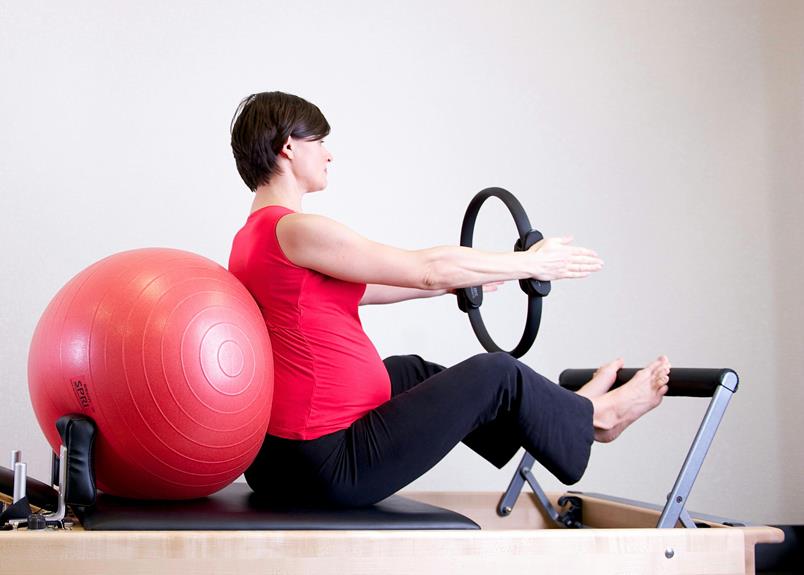
Blog
Are There Safe and Recommended Exercises for Pregnant Women?

During pregnancy, it's important to engage in safe and recommended exercises that can benefit both you and your baby. Consider trying activities like yoga, swimming, walking, and modified strength training to improve your flexibility, strength, and overall well-being. These exercises can help alleviate discomforts, manage stress, boost energy levels, and promote better sleep patterns. Explore the various options available and discover the positive impact they can have on your pregnancy journey.
Benefits of Exercising During Pregnancy
Exercising during pregnancy can help improve your overall health and well-being, providing numerous benefits for both you and your baby. Staying active can help alleviate common discomforts like backaches, fatigue, and constipation. Regular physical activity can also help you manage stress, improve your mood, and boost your energy levels. By maintaining a healthy exercise routine, you can enhance your cardiovascular fitness and muscle strength, which may help during labor and delivery.
Furthermore, exercising while pregnant can promote better sleep patterns and reduce the risk of developing gestational diabetes. It can also help control weight gain, decrease swelling, and improve circulation. Your baby can benefit too, as maternal exercise has been linked to a lower risk of excessive birth weight and a reduced chance of childhood obesity. Remember to consult with your healthcare provider before starting any new exercise regimen to ensure it's safe for you and your baby.
Yoga for Pregnant Women
During pregnancy, incorporating yoga into your exercise routine can offer numerous benefits to both you and your baby. Yoga helps improve flexibility, strength, and balance, which are essential for carrying the extra weight and maintaining stability as your body changes during pregnancy. The gentle stretching and breathing techniques in yoga can also help alleviate common pregnancy discomforts like back pain and swollen ankles.
Additionally, practicing yoga can help reduce stress and promote relaxation, which is beneficial for both you and your baby's well-being. By focusing on breathing and mindfulness during yoga sessions, you can create a sense of calm and connection with your body and your growing baby.
It's important to choose prenatal yoga classes or modify poses under the guidance of a qualified instructor to ensure the safety of you and your baby. Avoid poses that involve lying on your back for an extended period or put pressure on the abdomen. Listen to your body, stay hydrated, and enjoy the physical and mental benefits that prenatal yoga can provide during this special time.
Swimming as a Safe Workout
Swimming provides a safe and effective workout option for pregnant women to stay active and maintain their fitness during pregnancy. It's a low-impact exercise that helps strengthen your muscles, improve your cardiovascular health, and support your joints without putting too much strain on your body. The buoyancy of the water also helps relieve the pressure on your back and pelvis, making it a comfortable workout choice as your belly grows.
Swimming is a great way to stay cool and refreshed while working out, especially during the warmer months of pregnancy. It can also help reduce swelling in your legs and ankles, a common discomfort during pregnancy. Additionally, swimming can improve your flexibility and endurance, which can be beneficial during labor and delivery.
Remember to listen to your body and avoid overexerting yourself. Start slowly and gradually increase the intensity and duration of your swims as you feel comfortable. If you have any concerns or medical conditions, consult with your healthcare provider before starting a swimming routine during pregnancy.
Walking: A Low-Impact Exercise
Opting for a leisurely stroll is a gentle and beneficial way to engage in physical activity during pregnancy. Walking is a low-impact exercise that can be easily incorporated into your daily routine. It helps improve circulation, maintain a healthy weight, and boost your mood. Plus, it's a great way to stay active without putting too much strain on your joints.
When walking during pregnancy, make sure to wear comfortable shoes, stay hydrated, and listen to your body. Start with shorter walks and gradually increase the duration as you feel more comfortable. Walking on flat surfaces is generally safe, but be cautious on uneven terrain to prevent any accidents.
Additionally, walking can be a social activity. Consider inviting a friend or your partner to join you for a stroll. It's a wonderful opportunity to connect, share experiences, and get some light exercise together.
Modified Strength Training Exercises
Looking to enhance your strength during pregnancy in a safe way? Modified strength training exercises can be a great option for you. These exercises focus on improving muscle tone, endurance, and overall strength while taking into consideration the safety and comfort of expectant mothers.
During pregnancy, it's essential to modify traditional strength training exercises to ensure they're safe and suitable for you and your baby. For example, using lighter weights and performing more repetitions can help prevent straining your muscles while still providing a beneficial workout. Additionally, focusing on exercises that target multiple muscle groups simultaneously can help save time and energy.
Some recommended modified strength training exercises for pregnant women include bodyweight squats, modified push-ups, standing leg lifts, and seated rows using resistance bands. These exercises help strengthen key muscle groups such as the legs, core, and back, which can be beneficial during pregnancy and labor. Remember to listen to your body, stay hydrated, and consult with your healthcare provider before starting any new exercise routine.
